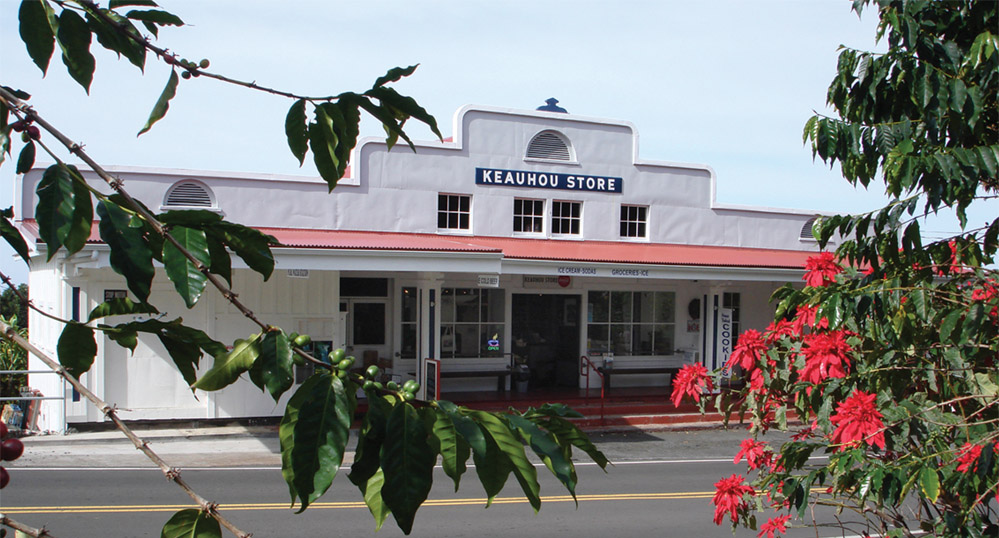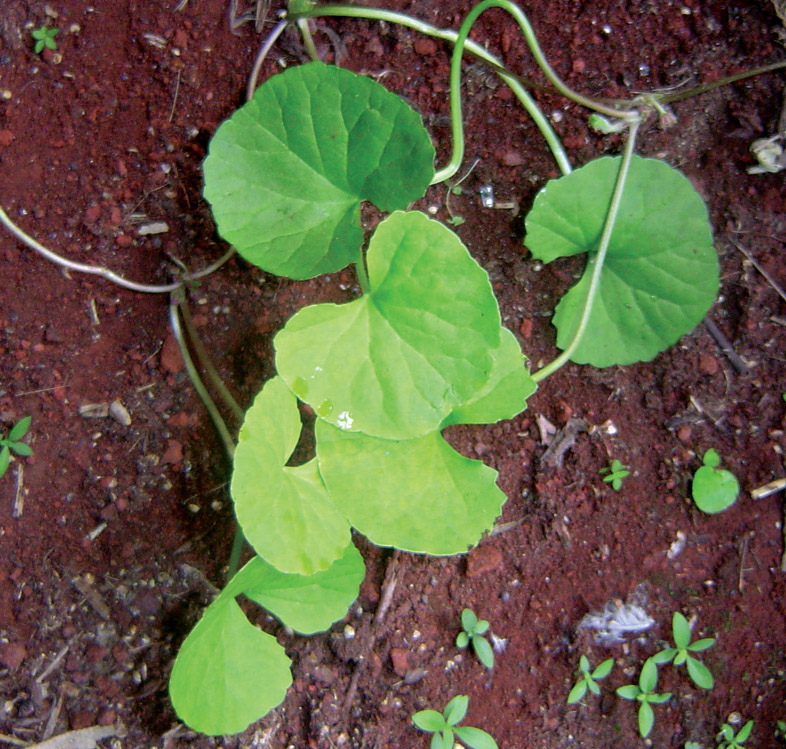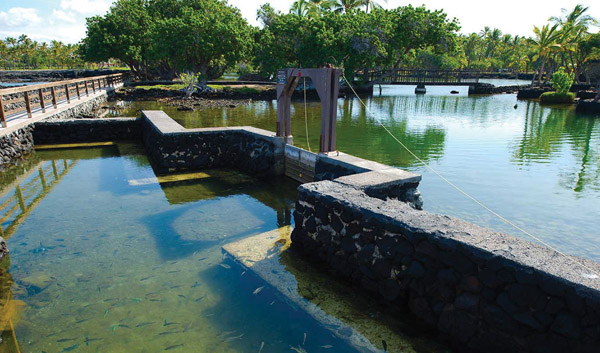
Weaving Kona: Aunty Jo Barney’s Life’s Work

By Kate “Kealani” H. Winter
Her hands move with quick certainty taming the narrow lauhala strips into a pattern that often only she can see. Today she is weaving a hat that is going to Mexico when it is finished. That bit of information slips out between stories of other hats, her ‘ohana, the history of Hawai‘i, and this island’s intimate past. Josephine Barney weaves in many ways.
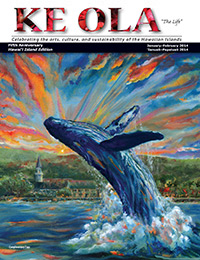
Born in Kailua-Kona into a Filipino family that has been here for more than a century, she is the living memory of this place and its people. She was the oldest girl in a family of nine, and Josephine Palacat was a child full of mischief, a tag along kid, keeping up with her five brothers and always listening, storing up the stories of Kona.
She recalls how the children of pre-World War II Kona made their fun with whatever was available when the only transportation from Honokōhau to Kailua other than bare feet was donkey or canoe.
She chuckles before she even starts to tell about riding to school on the family’s donkey, five siblings clinging to his bare back for the five miles from Honokōhau to the two-room school that sat where the Kailua Library is now.
The black donkey had been saved from a man who beat him, and Josephine’s father had thoroughly tamed him by soaking the children’s dirty clothes in water that he then gave the donkey to drink. When the children were unloaded at school, he was turned loose for the day to “horse around,” as she puts it. At the end of the school day, they would simply call him, and he would return to pick them up for the ride home.

When the children were older, a school bus was needed to take students mauka to Konawaena School. A Ford flatbed truck was outfitted with a roof, benches along the sides and down the center, and a chicken wire “cage” around the back. The wire did more than keep the youngsters safe aboard—it deterred them from picking guava along Ali‘i Drive as the “school bus” rumbled down what was then a one-lane dirt road. The memory brings a rascal’s smile from Aunty Jo as she confesses that sometimes they would tie a hapless student’s hair or belt to the wire for fun.
Having grown up where there were no perennial streams and little water except the ocean and shoreline ponds, Aunty Jo is brimming with stories about water. Her father was an expert fisherman, and she was taught all about nets and lures, including how to make them. If you ask, she will tell you about the shark in Kamakahonu (Kailua Bay) that he had made a bargain with. He would call the shark to him when he was ready to fish by thumping on the side of the canoe three times. The shark would come out of the deep water, and her father would promise to feed it when it brought back fish. When the shark returned surrounded by ‘ōpelu, her father would cut up the first three fish he caught and hand feed them to his finned fishing partner. Like many of the tales she weaves, this one leaves some folks suspended in delight and disbelief, especially when her merry laugh erupts and she shrugs slightly. Believe or not, she does not care.

From the magical tale of her father communing with whales out at Honokōhau when he was caretaker of the fishponds, to the story of a mysterious stranger in white who foretold their donkey finding a good source of drinking water nearby, many of Aunty Jo’s stories are connected to Kona’s waters.
One special wellspring in the village on a spot in front of St. Michael’s Catholic Church was a place where anyone could go to get drinking water when it was needed. The well needed to be protected and children needed to be kept safe from falling in, so a grotto was planned.
Josephine’s brothers—with her tagging along—would go down to the church after school, get a crowbar and wheelbarrow, and head out to collect coral clumps in the shallows in front of Hulihe‘e Palace and farther south. The older boys built the cement form and cemented the coral in to create the grotto that stands today where St. Michael’s is being rebuilt. An opening was left on the south side so anyone could still get water there when they needed to. She will tell you sadly that more recently people who didn’t understand its significance fouled the well and it had to be walled up.
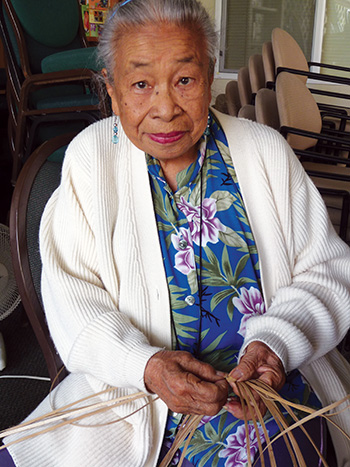
While she talks, her hands do not stop tugging and folding the lauhala strands in her lap.
Aunty Jo learned to weave when she was only five years old. She describes Hulihe‘e Palace in those days as “my playhouse and school.”
The Victorian style pavilion built by King David Kalākaua on the north side of the palace was still standing after the royalty were gone. Today the walkway that leads from the front lānai to the wooden structure ends in the grass, seeming to go nowhere. Aunty Jo points it out as if she can still see the shaded platform where kūpuna would gather to weave lauhala mats, hats, and baskets, and fishermen sat to mend their nets or make new ones. In the breezes off the bay, they shared laughter and gossip, songs, and stories while they worked.
Little Josephine listened, storing up the voices and incidents, stowing them in the remarkable memory she has. Her willing hands were guided to making lauhala mats, and her nimble fingers eventually accomplished more complicated designs. After beginning school at the age of seven, she would return home from school, do her homework, and then weave a pāpale pā, the crown for a lauhala hat that her mother would finish weaving the next day. Together, mother and daughter produced five or six hats a week, using the cash for clothes and eventually a sewing machine.
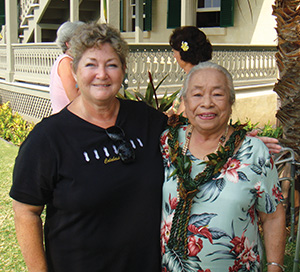
The Palacat ‘ohana lived in several places in the district of Kona, from Kaloko Pond to Kalaoa to Kailua Village. She lovingly remembers the house at Honokōhau that her father built with a sand floor that she had to rake every day and how she took pride in making lovely patterns in the sand. Around the interior walls of the house, wooden platforms about four feet above ground were wide enough to sleep on and left the center of the room open to the sandy floor. Even though there were no beds, each child had a bedroll—a pillow, blanket, and a Japanese-style mat—that was rolled and stored in a corner of the one-room house during the day. She and her mother did laundry in a nearby cave with soap that she helped her mother make. With no clothesline, they spread the wet clothes on the pāhoehoe to dry. Sometimes she and her mother would walk along the shoreline gathering sea salt from where it had dried on the rocks in order to dry their own fish catch and to trade with mauka folks for produce.
Later, her father was offered an old house up in Kaloko that he tore down to have materials for a house in town. After soaking the wood in a salty pond, he built a home where the King Kamehameha Hotel is now. Most of her young life was connected to the ocean and shore, and eventually her parents found a place up in Keopu where they could pick coffee during the season and have a safe place to evacuate if necessary from their home makai.
Josephine was an apt student who loved school. Her parents took her out of the classroom when she was 15 and her hope of becoming a schoolteacher ended. Aunty Jo says her mother was afraid she would marry a haole and so arranged a marriage to a Filipino man. Being a Catholic, Josephine says she finally—after several attempts at escape—“accepted my fate.”
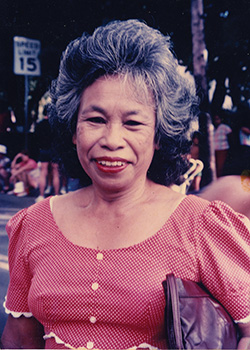
Farm work replaced weaving, fishing, and school. They grew tomatoes, beans, peas, and coffee and processed them for sale, with Josephine driving an old truck to Hilo across the island’s “saddle” to deliver the produce. The first of her four children born in those years was her son Cirilo, whom she took along on the cross-island trip safely tucked into a re-purposed Carnation milk crate for crib and carrier. Three other children were soon hānai or adopted into the ‘ohana, making more hands, but also more work.
Two more husbands, five more children later, and after living in California for 18 years, she returned to Kailua-Kona. Once home, she stopped to visit her beloved Hulihe‘e Palace and talk story with her friend, Fanny Au Hoy, who recruited her as a docent. In a soft mu‘umu‘u, her diminutive figure gave gracious welcome to all who passed through the palace grounds. She was the very embodiment of aloha, interpreting the story of Hawai‘i, Hulihe‘e Palace, the monarchy, and the life of Kona. Her dozen years as docent were filled with tours that visitors enjoyed so much that they would linger afterward or return another day to hear more. On days off she might be found sitting cross-legged on a lauhala mat spread out on the palace lawn, repairing the old mats that protect the wooden floors of Hulihe‘e or telling a willing student how to climb the hala tree and get the leaves to prep for weaving, all while sharing a colorful story about remembered characters and places along the Kona coast.
The urge to teach has never subsided and she has found many ways to express it. While in California she became a nutrition educator, and when she came home to Kailua-Kona, she worked at local resorts teaching lei-making, lauhala weaving, and basic hula. She danced for Uncle George Na‘ope on the cruise ship Constitution, at Uncle Billy’s, Lava Java, and almost anywhere there was Hawaiian music.
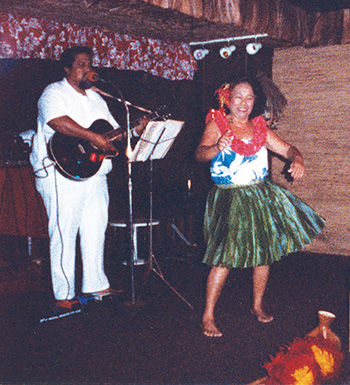
These days she can be found at Hualalai Regency working with lauhala, playing ‘ukelele, and dancing. Her hula hands—strong, nimble, and graceful—tell the stories while she dances, and she can still flick a skirt and toss a flirtatious wink as well as any hula dancer half her age.
Life in old Kona may seem primitive to people used to the Internet and global travel, and yet Aunty Jo remembers that they never went hungry and always had clean clothes. The community strung along the coastline from Kohanaiki to Keauhou was generous and loving, a place where all kūpuna shared the work of looking out for the keiki of Kona.
Under the palms on the makai side of the palace one breezy afternoon last year, Aunty Jo offered a group of rapt listeners this final advice: “Have Aloha for each other, respect each other, pick the flowers, leave some fish in the ocean, and most important, be Aloha.”
At eighty-seven, she still entwines those lessons with Kona’s history and her own while her fingers command and coerce the fibers to bend to the weaving that her life is. ❖
Family archive photos from Aunty Jo’s daughter, Mary Shannon.
Contact Aunty Jo Barney: Regency at Hualalai, Apt. C-507
Contact writer Kate “Kealani” H. Winter: khwinter@hawaii.rr.com
